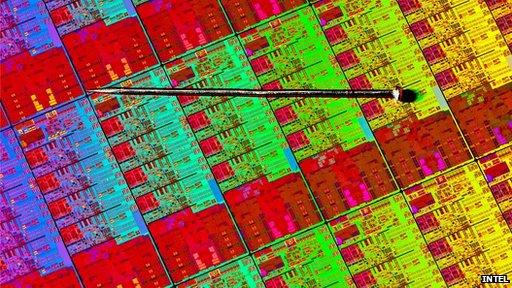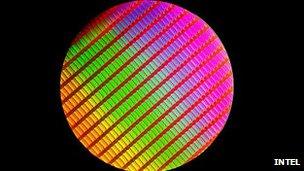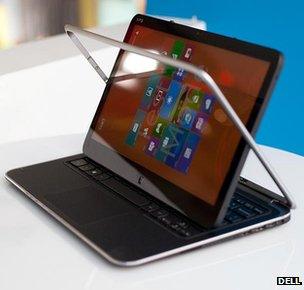Intel's Haswell chips are engineered to cut power use
- Published

The size of the Haswell processors - seen here before being divided from a silicon wafer - is smaller than a nail
Intel has released early details of its Haswell computer chips, due for release in the middle of next year.
One version of the processors will run at 10 watts, about half as much as its current Ivy Bridge design.
It said the improvement would mean devices could become thinner, faster and offer extended battery life.
In addition it said the chips were designed to better support "perceptual" tasks such as voice recognition, facial analysis and depth tracking.
Intel is the world's biggest semiconductor supplier to laptop and desktop PC manufacturers, outselling its x86-based chip rival AMD.
However, the rise of Apple's iOS, Google's Android and the upcoming release of Windows RT - operating systems designed for chips based on ARM's rival architecture - means that it has missed out on much of the fast-growing tablet computer sector.
ARM-based designs were picked because of their reputation for low-energy use. But Intel hopes to gain an advantage by offering chips that can support the full Windows 8 system while using less energy than at present.

Intel unveiled details of the chips at its developers conference in San Francisco
"Battery life, for example, on an ultrabook next year will be nine hours for a system that would deliver five hours today," Adam King, Intel's director of notebook product marketing told the BBC.
Centralised chips
Haswell represents the "tock", external in Intel's "tick-tock" development model: "Tocks" represent a redesign of a chip's architecture, while "ticks" concentrate on shrinking the size of its transistors.
As such Haswell chips retain the 22 nanometre process used to make the current generation of processors, but overhauls their design.
One of the key innovations has been to merge the chip's CPU (central processing unit) with its PCH (platform controller hub).
The CPU carries out calculations and program instructions, while the PCH handles input and output including connections to USB peripherals, audio, and storage.
In the current Ivy Bridge design the CPU uses 17 watts and the PCH a further 4 watts, giving a total energy requirement of 21 watts.
But this has been reduced in Haswell.
Intel plans to release two versions of the processor, one requiring 15 watts, the other 10 watts, marking energy savings of 29% or 52% respectively.

Devices such as Dell's upcoming Windows 8 hybrids show manufacturers experimenting with designs
"By putting them together in a single chip package we are able to get a lot of power reductions," Mr King said.
Sleep together
He added that customers would also benefit from Power Optimiser - a new process that aims to reduce power-consumption when a device was not in use
"When you have multiple devices or peripherals on a PC they have their own schedule as to when they ping the operating system and say 'I'm still here', or 'I've had a change in status, can someone plug a thumb drive into me'.
"By having these things occur randomly the system is using lots of power even when it's in an idle state. What the Power Optimiser scheme does is harmonise all these signals so that you go out once and check all your peripherals to see if there is a change in state and then go back to an idle state.
"It's like parents with triplets trying to get some sleep through the night - if each child is waking up at different hours then mum and dad are going to be awake all night. Wouldn't it be great if you could get all three to just wake up at the same time and go back to sleep together."
Speech recognition
Another innovation on the new chips is a more powerful GPU (graphics processing unit). This is designed to handle tasks in which a large number of calculations can be carried out simultaneously, rather than one-at-a-time.
Speech and face recognition are highly parallelisable tasks and will thus benefit from this improvement.
Intel is working with speech-recognition company Nuance to create a software kit to help developers best unlock the chips' potential.
In addition it suggests Haswell-based computers will also be better suited to tracking objects placed close to their camera sensors allowing further development of gesture controls and augmented reality.

ARM-based chips are the dominant processor technology for smartphones, tablets and TVs
While such advances may help Intel continue its dominance of the PC-market, one analyst suggested that it might remain a niche player when it came to tablets, at least in the short term.
"ARM's current dominance in the sector comes from the fact they were in the smartphone business when Intel wasn't and this technology has now been leveraged for tablets," Sergis Mushell, principal research analyst at Gartner told the BBC.
"This allowed people to innovate and create a new ecosystem in which many of the tablet makers - such Apple and Samsung - make their own ARM-based chips, and it would be very difficult to adapt these machines to run on Intel chips in the short-term.
"But if a tablet comes out that has the true performance of a laptop and the backward compatibility to all the work and creativity users can do on a Windows computer, then Intel has a shot to run alongside ARM... with an alternative form factor to a clamshell."
- Published6 August 2012
- Published15 May 2012
- Published23 April 2012